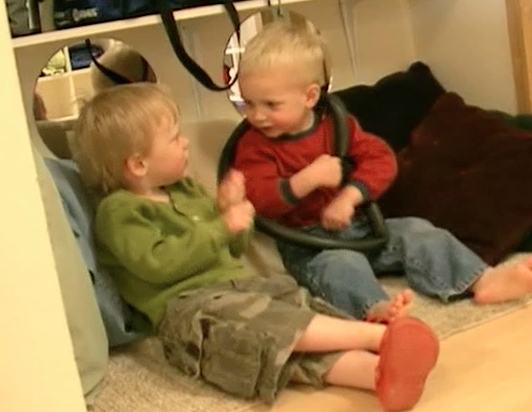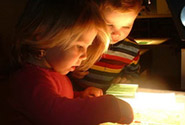Jul
28
Videatives Views Issue #211 Early Communication
 This video shows children of different ages working to accomplish the same thing – engage in communication with peers. Watch as pair of infants, a trio of one-year-old children, and a pair of two-year-old boys uses different strategies to communicate with each other.
This video shows children of different ages working to accomplish the same thing – engage in communication with peers. Watch as pair of infants, a trio of one-year-old children, and a pair of two-year-old boys uses different strategies to communicate with each other.
Infants (time code 0:05 to 0:30)
What do infants do to elicit the attention of a friend and capture his interest? Two infants sit across from each other, just beyond reach. The girl leans in (0:05) and makes eye contact with the boy (0:05 – 0:07). The boy may be excited to see the girl as he raises his arms and waves them up and down (0:06 – 0:10). He pauses his actions, perhaps to show that he is anticipating some sort of reaction from his friend – he waits for the girl to do something in response (0:09 – 0:11).
The girl acknowledges the boy’s overture and offers a reply. She maintains eye contact and imitates his action by raising her arms up and down (00:09 – 00:11). The boy works to sustain their communication by waving his arms up and down in response (0:12 – 0:15). He may think, “My friend responded when I waved the first time, so let me give it another try.” He pauses once again (0:15 – 0:16) as if to signal to the girl that it is her turn. She reads his cue and responds by waving her arms excitedly (0:16 – 0:19). With the completion of a second round, the infants are beginning to co-construct a predictable pattern of interaction. The girl leans forward and babbles to the boy as if to celebrate that they are doing this together; this is shared communication (0:19 – 0:21).
A circle of light moving across the carpet captures the girl’s interest (0:22 – 0:29). The boy works to regain her attention by waving his arms up and down (0:23 – 0:26). When his actions do not elicit a response, the boy looks down and touches the smooth floor, perhaps sensing that their communicative exchange has ended (0:27 – 0:29).
One-year-old children (time code 0:31 – 1:21)
This next segment shows that early communication between one-year-old children is often constructed around an object (toy) as a shared referent. The role of body in communication becomes less central as the child learns to construct relationships between oneself and objects in the world, and the then share information about those objects with peers during social interactions.
Watch as the girl in the video works to capture the interest of her peers by presenting a toy pig and then waiting for her peers to respond. The girl knows that an object is portable, and she brings it into closer proximity by carrying it toward the boys. She pauses and rotates the pig so that the legs are orientated downward (0:32 – 0:35). Certain that the legs will hit the floor first, she makes an emphatic placement (0:35 – 0:37). Perhaps assuming that the object will be more readable by her peers (intended audience), the girl orients the pig so that it stands up.
While remaining nearby, the girl completely moves her hands away from the pig (0:38). Is she offering the toy to her peers? She might intend her action to mean, “I possessed the pig, but now you can possess it too.” Perhaps the ability to stand freely is an exciting feature of the toy that she wants to share by offering the boys an unobstructed view. An object that does not fall over has some autonomy. The girl repositions the pig, perhaps to imply that the animal toy has movement. She faces the head toward the boys and says, “Pig” (0:40 – 0:41). The boys approach, and quickly she animates the object by “walking” the pig forward (0:42 – 0:44). The girl frames the boys as her audience for show and tell. She’s communicating to the other children what she knows about the object: it has legs; it can stand autonomously; this is what it’s called (pig); here’s what it’s supposed to do (walk); the head indicates the direction of movement, etc. The girl took a risk in showing the toy pig. The boys found the toy pig so interesting that they decided to take it (0:46), and one boy carries it along with him.
The second boy discovers another interesting object, a Wiffle ball (0:57). He approaches his peers and extends his arm as if to show the ball to the other children (1:00). He also makes repeated vocalizations that sound like, “I got. I got.” He may assume that the ball gives him some status and presence among his peers. Contentedly, the boy wearing overalls continues to carry the toy pig (1:00). The girl turns and looks at the Wiffle ball (1:00), but then turns away (1:03). Why doesn’t the Wiffle ball inspire a stronger response from the boy’s peers? Although the Wiffle ball represents something that can be shared in a social context, the boy clutches it in his hand. The other children likely recognize that the boy is inviting them to note his enhanced status – “I am the boy with the ball,” and understand that the ball is not being offered.
The boy may enjoy possessing the object as he grasps the ball with both hands and hugs it to his chest (1:07). Or, he may want to safeguard the ball by trying not to drop it as he moves across the room (1:08 – 1:12). He babbles enthusiastically, saying something that sounds like, “Hi yah,” (1:07) and walks to a seated child. He makes eye contact with the child as he repeats, “Hi yah. Hi yah” (1:17 – 1:19). His vocalizations seem intended to share, but as he holds the Wiffle ball close, his body language designates the ball as his possession. He may be trying to say, “Look what I have.”
Inviting others to “see what I’ve got,” creates a more limited social interaction than “showing and telling” about an object. Perhaps the girl with the toy pig has more of a sense of audience. Or, perhaps the children have different attitudes about the other. The girl may have more trust, whereas the boy may fear losing the object. It could also be that a child feels more confident sharing an object that stands autonomously in place (toy pig), than an object designed to roll (ball).
Two-year-old children (time code 1:22 - 3:12)
The third segment shows that early communication between two-year-old children is constructed around shared meanings and symbolic gestures. If a younger child has a ball, he can lift it, roll it, throw it, or give it to a friend. For a two-year-old, the ball is a prop that he can transform into a symbol for something else. The same object can have different names because the object is not literal. The challenge is that the child has to let others know what the prop represents. The object is a symbol, and communication becomes meta-symbolic. That is, instead of assuming that his playmates know what an object (bicycle inner tube) represents (seat belt, guitar), the child communicates the objects’ symbolization through words, gestures, placement, etc. The children may also discuss ways to transform an object (inner tube) into a symbol (guitar) that effectively conveys meaning, e.g., “Hold it like this. No, put it over your head.”
Max (wearing green) and Justin (wearing red) are engaged in pretend play. Max pretends to “take a bite” (1:29) and makes a chomping sound (1:32). Justin reflects on the power of Max’s symbol; that is, he shares a meta-comment by suggesting a way to strengthen his symbol. Justin says, “Take a bite like this” as he makes a louder, growl-like biting sound (1:35).
Justin then seamlessly transforms a single object (prop) into a series of different symbolizations. Notice what Justin does to successfully communicate to his friend, Max, what the object now represents (seat belt, guitar). Consider how the symbol is motivated by the various ways Justin relates the prop to his body. He selects a bicycle inner tube as a prop. Justin wants Max to know the symbolization that he has assigned the inner tube, so he announces it. Justin says, “I got my belt on. I got my belt” (1:43 – 1:47). He enhances the symbol by placing the belt over his head and positioning it across his body like a seatbelt (1:50 – 1:53).
Both Max and Justin gesture with their hands (1:54) making a motion that resembles wheels going round. Justin looks at Max’s hands and says, “No, you’re not driving. I’m driving” (1:58). He may be thinking, “Only one person is the driver in a car, and I am the one.” The boys walk across the classroom together and Max shares that he is “going swimming today” (2:11). Max and Justin stand side-by-side in a small space – perhaps a vehicle, and Justin briefly transforms the inner tube into a steering wheel while making a buzzing sound like a motor (2:20 – 2:23). He alerts Max that their ride has ended by saying, “We’re here” (2:24).
Justin reinvents the inner tube as a guitar. He stands like a performer on stage before his audience (Max), drapes the inner tube across his body like a guitar strap, and gestures with his hand as if plucking the strings as he sings, “So, let’s have some fun boy” (2:36 – 2:41). The inner tube may next become a flotation device as Justin says something that sounds like, “We gotta swim,” and runs across the room with the tube around his shoulders (2:43 – 2:58).
He signals Max that once again he has transformed the inner tube by chanting, “Magic guitar. Magic guitar” (3:00 - 3:02). Max affirms Justin’s symbol by saying, “Your magic guitar. Magic guitar whirring” (3:02 – 3:07). Justin gestures as if strumming the guitar (3:06 – 3:08). Recall that earlier, he plucked the guitar strings. Perhaps Justin knows, and wants to represent, two different ways to play a guitar. We might add that Justin's ability to effectively communicate to Max helps maintain Max's involvement in the games Justin invents. Good communication spawns good leadership.


